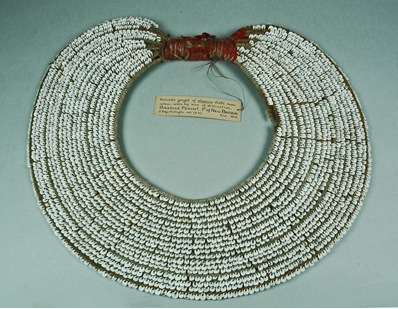Warrior’s shell collar
Gazelle Peninsula, Papua New Guinea
 Purchased from J. Edge Partington in 1913; 1913.65.20This large neck ornament or 'collar' is from the Gazelle Peninsula, part of the island of New Britain in Papua New Guinea. It is made from hundreds of small white snail shells, called Nassa shells, sewn onto rattan strips that are then attached side by side up to twenty rows deep. Such collars were worn by Tolai men in battle as ornaments of distinction but also as powerful charms, affording magical protection to the wearer.
Purchased from J. Edge Partington in 1913; 1913.65.20This large neck ornament or 'collar' is from the Gazelle Peninsula, part of the island of New Britain in Papua New Guinea. It is made from hundreds of small white snail shells, called Nassa shells, sewn onto rattan strips that are then attached side by side up to twenty rows deep. Such collars were worn by Tolai men in battle as ornaments of distinction but also as powerful charms, affording magical protection to the wearer.
The Tolai people used these same Nassa shells, as currency. Different kinds of shells – either whole, flaked, or shaped into beads – have been used as currency at some point in every continent's history. Among the Tolai, shell money was called tabu or tambu, made by stringing the shells onto lengths of rattan. When the shell string became very long (as much as several hundred metres), it was rolled into a ring and bound with leaves. The rings represented a man's wealth and were stored in a special house. An increase in wealth through the acquisition of additional tabu meant an increase in status as well.
Among indigenous peoples, as in the West, fashions change. As early as 1906, a visitor to New Britain noted that these collars were no longer made, and that a collector would have to be lucky to obtain one in good condition, and only for a high price. The shell money rings too are no longer made, but shorter strings of shells were still occasionally used as small change as late as the 1970s.
